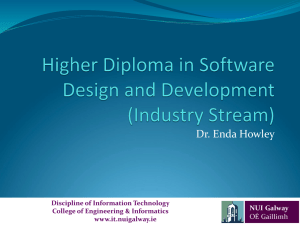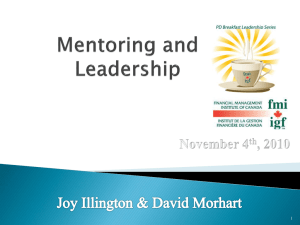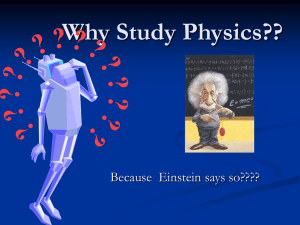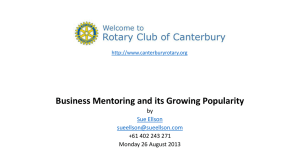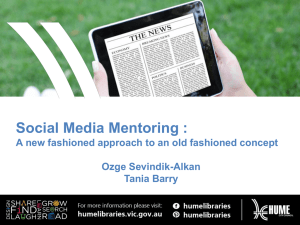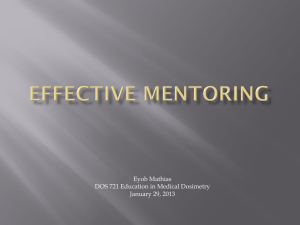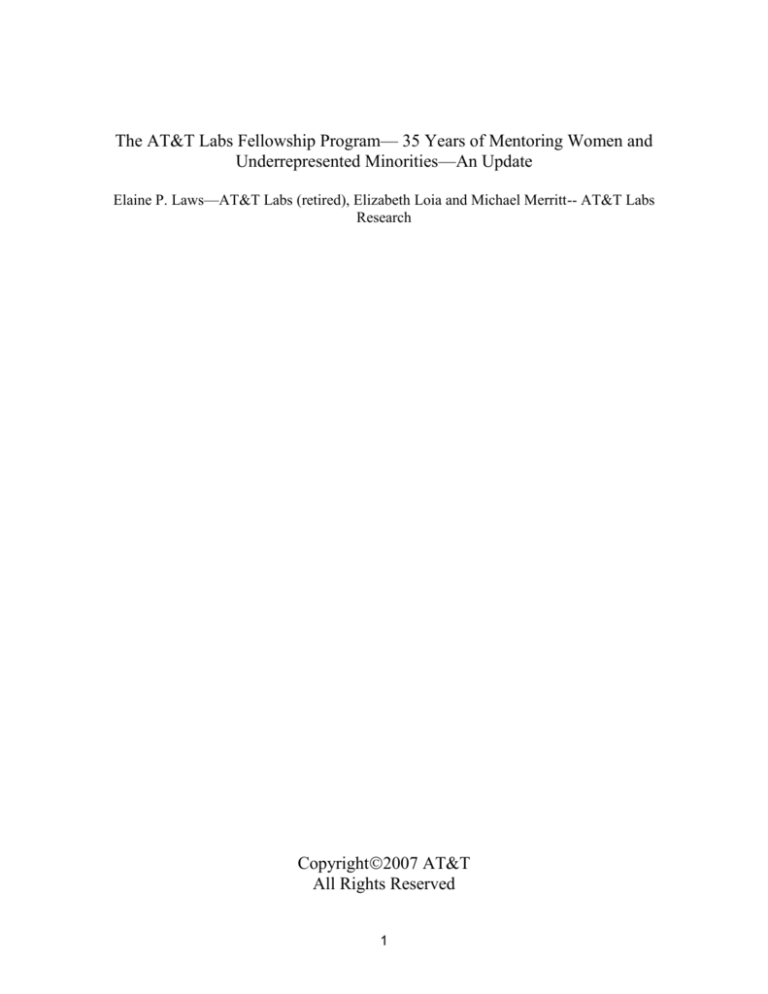
The AT&T Labs Fellowship Program— 35 Years of Mentoring Women and
Underrepresented Minorities—An Update
Elaine P. Laws—AT&T Labs (retired), Elizabeth Loia and Michael Merritt-- AT&T Labs
Research
Copyright2007 AT&T
All Rights Reserved
1
The AT&T Labs Fellowship Program— 35 Years of Mentoring Women and
Underrepresented Minorities—An Update
Elaine P. Laws—AT&T Labs (retired), Elizabeth Loia and Michael Merritt-AT&T Labs Research
Abstract
The AT&T Labs Fellowship Program (ALFP) has a 35-year history of mentoring women
and under-represented minorities pursuing doctoral degrees in science and engineering.
Five years ago during its 30th anniversary ALFP and its predecessor programs were
celebrated at a joint AT&T Labs and Lucent Bell Labs conference1 and at the American
Society for Engineering Education Annual Conference and Exposition.2 An earlier paper
presented at these venues reported on the programs’ history, participants, and impact. In
this new paper the authors provide an update of the current program at AT&T Labs and
its evolution and results over the last several years as the company and industry have
changed. Significantly, the need for new graduates in science, mathematics and
engineering has remained a nationwide imperative,3 and the challenges of students
competing in these areas continues to require mentoring and professional development to
succeed in advanced studies and be well-prepared for the dynamics of careers in
technology.
We discuss current aspects of the ALFP, its selection process, program requirements,
mentoring and internship components as well as the unique community of researchers
who support the program. Information on the sources of candidates, the disciplines they
pursue, the institutions at which they conduct their studies as well as the areas and fields
they intend to enter upon completing their degrees are updated from the 2002 paper.
Additionally, discussion of the mentoring networks provided to students in the programs
and comments from recent and current students and their mentors are summarized to
describe the benefits of the program. 4
1
Mentoring for Success, Joint Conference of AT&T Labs and Lucent Bell Laboratories, October, 2002.
E. P. Laws, “Looking Back Over 30 Years—AT&T Labs and Lucent Bell Laboratories Ph.D. Fellowship
Programs 1972-2002,” Proceedings of the 2003 American Society for Engineering Education Annual
Conference & Exposition, 2003, American Society for Engineering Education.
3
G.W. Bush, State of the Union Message, January 2006.
4
The paper reflects data from the AT&T Labs program only (from 1996-2006); the programs at Lucent
Bell Labs are not included in this report and information on those programs is most appropriately obtained
from that source, although we acknowledge that company’s continued efforts in supporting students in
technology fields and recognize our common history in this effort.
2
2
Introduction
Over ALFP’s 35-year history unprecedented changes, some of which include the advance
of information technology, the introduction of the internet, personal computers, and
wireless technologies throughout business and culture, the evolution of the civil rights
and women’s movements, the recognition of environmental concerns, and the
globalization of business and communications have occurred in rapid succession. These
technological, cultural and business advances relied on a diverse and aware population of
university graduates schooled to think differently and to investigate new ways of doing
things. The ALFP has strived to identify and support these types of thinkers and
innovators over the years. Additionally, the program has evolved through the changes in
the telecommunications industry and related businesses and the reorganizations of AT&T
in 1984 (divestiture), 1996 (trivestiture), and more recently in 2005 (acquired by SBC, an
evolved off-spring of the 1984 divestiture) and 2007 (acquisition of BellSouth and full
ownership of Cingular). Over the years, the program has selected students in disciplines
reflective of the work of the company and has adjusted these as its focus and business as
well as technology has changed. Prior to the 1980s, a major focus of research was in the
physical sciences; computer science and electrical engineering were in their
developmental years; in the last 30 years substantial changes have occurred in these
disciplines. Now these and other evolving technologies lead the way to the developments
of the future. Most importantly, the program continues to attract women and underrepresented minorities and to financially support, mentor and graduate them as Ph.D.
researchers in the fields of computer science, electrical engineering, mathematics,
operations research, and related fields.
While this paper will focus on the aspects and results of the ALFP over the past 10 years,
it is noteworthy that, to date, over 5005 students have been selected and supported by the
predecessor programs over the last 35 years.
Fellowship Program Awards
1972 - 1995
1996 - 2006
498*
54
Total
552
Table 1— Total Awards 1972 - 2005
*Includes 87 awards funded by Lucent
The current 76% rate of ALFP students completing Ph.D.s is consistent with the past rate
in the 70% range or better. The hallmarks of program support continue to include
financial support, mentoring, paid internships, and interaction with the AT&T Labs
research community, all of which are considered to contribute to the success rate of
students selected for the program.
5
Data includes students selected and supported by Lucent Bell Labs through 2002.
3
Program Overview
The AT&T Labs Fellowship Program continues to be available to outstanding underrepresented minority and women students who are U.S. Citizens and Permanent
Residents who are pursuing Ph.D. studies in computer and communications-related
fields. Fellowship awards are provided for 3 years and are contingent on an annual
review that demonstrates the recipient is making satisfactory progress toward their Ph.D.6
Financial support covers tuition, books, fees, approved travel expenses to professional
conferences, a living expense stipend and education expenses for summer study or
university research. During the first summer after receipt of the award, students are
required to complete a summer internship at AT&T Labs.
The mentoring relationships provided by the program emphasize close interaction
between the student and an AT&T Labs research staff member knowledgeable in the
student’s selected field of study. Significantly, the commitment of the AT&T Labs staff
that selects and mentor students continues to be strong and resolute. Prospective
candidates are matched to mentors based on the candidate’s interests and only if such a
match is possible is the candidate selected. AT&T Labs mentors work with first year
fellowship students during the first summer of their awards on site at AT&T and are in
contact with them throughout their university studies. Often, mentors will visit students
during the school year to support the progress of their work and will if appropriate,
advocate for additional summer internship assignments at AT&T Labs for the student
beyond the first year internship. (Such additional assignments, however, are competitive
and fellowship students must compete with other summer internship applicants after their
initial summer internship assignment.)
Fellowship students work as members of research teams on various ongoing projects
within AT&T Labs. The interaction by the student with the AT&T Labs research
community while working as an intern provides a special opportunity to the student to
learn about an industrial research facility and to attend technical talks and symposia
conducted by the organization. Students are welcomed as research collaborators and the
typical measure of a successful summer is an external technical publication…for many
students, this is their first experience being treated as a peer team member, very distinct
from typical hierarchical academic environments. Some program graduates go on to act
as role models to students from backgrounds like their own, encouraging them to explore
work in the fields of science, mathematics, and engineering. As a result, over the years it
is not surprising that students develop into peer researchers alongside their mentors.
Students are invited to submit applications for the ALFP and are asked to complete an
application form, provide official transcripts of grades from all undergraduate schools
attended, provide Graduate Record Examination scores, and three letters of
recommendation from college professors who can evaluate the applicant’s ability and
potential for research. Additionally, the applicant must provide a written statement of
interest and research and career goals. Applications are accepted until January 31 of each
6
Prior to 2003, awards were for a maximum of 6 years, contingent on satisfactory progress towards the
Ph.D.
4
year. Student applications are reviewed by the ALFP committee, which is comprised of
Ph.D. research and development professionals in AT&T Labs. A limited number of
qualified students are invited to interview with AT&T Labs R&D staff in the March
timeframe and final selections are made in April with student internship assignments
beginning in late May or June.
ALFP currently receives approximately 40 applications annually from qualified students
and invites about twelve applicants to meet with researchers to compete for the 5
fellowships awarded annually, reflecting about a 12% acceptance rate of applicants. The
areas in which students concentrate reflect the work the company is currently pursuing,
and have technical and mentoring expertise. The disciplines shown below (Table 2) over
the last ten years indicate the focus on computer and electrical engineering fields versus
past concentrations in Physics and Chemistry (Table 3).
1996 – 2006 Awards by Discipline
CS
EE
21
9
Other Engin
OR
10*
Math/Stat
4
4
Other
TOTAL
6**
54
Table 2—Disciplines—1996 –2006
* Includes Engineering, Accoustic Eng, CE, Eng. Psy, HCI, IE, ISE, Opt Eng
** Includes IT, Mat’l Sci, Robotics, Physics
1972 – 1995
Physics
72
Chemistry
47
Awards by Discipline
Math Engin CS
28
159
57
Other
5
TOTAL
368
Table 3—Disciplines 1972-1995
While ALFP students are specifically mentored by AT&T Labs staff throughout the years
they are funded in the program, they are as well a part of a larger community of
approximately 40 interns who annually are selected for key internships primarily during
the summer. The work these interns do is very valued by AT&T Labs and it is
noteworthy that they are doing “real” company work. At the end of the summer, all
interns present talks or papers on the work they have completed and such forums are
well-attended by regular Labs staff who seek to learn from the students as well as link
them to other efforts that may be related to their work.
Some awardees obtain alternative financial support, in which case their ALFP support
changes to a small annual grant and some travel support. This financial link serves to
encourage and reinforce the mentoring relationship forged during the initial summer
internship.
5
Currently in the ALFP there are 22 students in progress, receiving support from AT&T
Labs in the form of funding, internships, and mentoring (reflecting 2001- 2006 student
cohorts as indicated below).
ALFP Student Cohorts 2001- 2006
Male
Female
37%
63%
Ethnicity
African American
Hispanic
White (female)
Asian (female)
27%
27%
36%
9%
Table 4—Current ALFP student population
Students currently funded by ALFP were drawn from a large cross-section of US
universities as they have over the history of the programs. The schools include a mix of
state and private institutions as well as Historically Black Colleges and Universities and
Hispanic Serving Institutions. The table below reflects the undergraduate school sources
of students in the 2001-2006 cohorts. (The appendix at the end of this document provides
the list of schools in which current students are enrolled in Ph.D. programs.)
Undergraduate Schools of Current ALFP Students
Alabama A&M
Arizona State University
Brown
Carnegie Mellon
Florida State
Georgia Institute of Technology
Harvard
Johns Hopkins
Michigan State
Morehouse
Princeton
Rice
Swarthmore
University of California—Berkeley
University of Colorado—Boulder
University of North Carolina
University of Oregon
University of Pittsburgh
University of Puerto Rico
University of Rochester
Washington State
Table 5—Sources of current ALFP students
6
Program Value
While ALFP has been described as “the opportunity of a lifetime,”7 many students
accepted into the program understand quickly that while the financial support is
important to their success, the mentoring aspects of the program make the difference in a
student’s Ph.D. career. Other Ph.D. scholarship opportunity programs provide financial
support, but rarely provide the one-to-one mentoring relationship of ALFP.8 A recent
graduate of the program notes that while the financial support and internship experience
were excellent, the support of their mentor made the difference for them as they
progressed through their Ph.D. studies.
“ If anything goes wrong at the university (poor relationship with your advisor, overt
discrimination, difficulty with coursework) the mentor is experienced enough in academia to offer
good advice and moral support. This prevents students [from] becoming demoralized and
quitting. In my case I had a difficult relationship with my advisor (although it improved by the
end) and the ability to discuss how to manage him with someone outside of the university was
very helpful.”
Another student comments on how the mentor helped them think through decisions when
it was not as easy to communicate with an advisor, while still another notes the value and
respect they have for their mentor’s opinions.
“ I have at times had difficulties with my [university] advisor, due to very different
communication and working styles. At these times, it was reassuring to know that I could pick up
the phone anytime and talk to my mentor about things, get advice when I needed to make a
decision, or just have someone to talk to.”
“My mentor has been someone I know, trust, and respect, and whose advice is a
telephone call away has been useful on numerous occasions.”
In the book Leaving the Ivory Tower, the author notes that many Ph.D. students
withdraw from doctoral programs although they are more than capable of completing
them. The reason suggested is that those who have a higher frequency of interaction with
their advisers are able to develop professionally to a greater degree than students who do
not.9 With ALFP mentors in frequent contact with students supported by the program,
students have access to advice, professional information and ideas that other students do
not. They also have access to the formal and informal networks that are inherent in the
Labs R&D and internship community. In the quotes below, students comment on the
value of the relationship between the mentor and protégé and professional technical
community.
“ The mentor can integrate the student into a community of researchers. People are
more inclined to give credibility (and thus jobs, internships, funding) to people they know have
worked with people they respect. The mentor provides the seeds of this for the student. The
7
ALFP description (see http://www.research.att.com/academic/alfp.html).
See Graduate Fellowships (http://www.cs.dartmouth.edu/gr_fellow.php).
9
B. E. Lovitts, Leaving the Ivory Tower, 2001, pp 2, 94, 146.
8
7
summer internship is the key to this. There is no substitute for getting to know people in the work
environment.”
“ The main difference between AT&T and other fellowships is that as an AT&T fellow, I
feel that there’s a group of people out there that are genuinely interested in my success. It’s akin
to having a family support structure, but in an academic setting.”
The internship community is viewed as a special and significant workforce at AT&T Labs and is
considered to represent the rising talent in the field of research. Interns are valued for their fresh
ideas, new approaches and enthusiasm. In return they are exposed to research and project
management skills and have the opportunity to hone their analysis and presentation skills under
the direction of seasoned researchers.
“The AT&T ALFP is a great way to learn about new research but most importantly to
work with researchers and gain insight into the broad perspectives of a world-class researcher.
It is also a great way to establish relationships with other interns who will become professional
peers.”
Additionally, mentors with diverse backgrounds can add their personal experiences to
their interactions with students, providing additional credibility to their advice to students
in similar situations. Professor Charles Thompson, a past fellowship graduate and
advisor to the program, now at the University of Massachusetts—Lowell, mentored many
ALFP students over the years, advising them and working with AT&T Labs mentors and
university advisors to ensure that the students progressed successfully through their
studies.
“Both [my mentor] and Charles Thompson were significantly helpful. Charles
Thompson actually made a visit to [my school] to talk to me [when I had a difficult relationship
with my advisor] and later invited me for a visit to [his university].”
Other students find that their shared experiences with mentors of similar backgrounds are
invaluable to their success in their studies.
“My mentor has helped me in numerous concrete ways…. More subtly, though she
understands the nature of some of the difficulties I encounter, perhaps through a similar female
pedigree, but also because she has spent time befriending me during my internship and via email
over the last four years. Not only can she provide bonafide reassurance, but also caveats and
concern when she is aware I need to hear it….”
And other students, interning at other research organizations, have found that not all
mentoring is as effective.
“A few summers after my ALFP internship, I was chosen as a summer intern at [another
outside corporate research organization]….Both programs required me to give a talk at the end
of the summer…. My ALFP experience was better in that my ALFP advisor knew my weaknesses
and worked with me to strengthen them throughout the summer; at [the other company] my main
mentor left …midsummer, leaving me to figure out difficult concepts in my own. The backup
mentor…knew VERY little about the project I was working on. I struggled by myself to prepare a
sensible talk.”
8
Professor Antonio Rodriguez, also a past fellowship recipient like Dr. Thompson, who is
now at Arizona State University, has initiated mentoring programs at his university
giving back to the profession and community. Both he and Dr. Thompson have been
recognized for their specific mentoring contributions and have received Presidential
Awards for Excellence in Science, Mathematics, and Engineering Mentoring.10 Other
ALFP graduates and participants in the program have found that, having been mentored,
they are willing to mentor others, giving back a little of the benefits that have been given
to them through mentoring. Their comments below indicate their efforts with mentoring
more junior students, women, those from disadvantaged backgrounds and even at risk
high school students.
“I take every opportunity to mentor and encourage students to be the very best that they
can be in relationship to their academic careers. I try to encourage them by sharing the many
opportunities that are available to them, and use myself as an example that they can do it.”
“ I am in the final year of my Ph.D., now, and mentoring other junior students to
continue my research, as well as mentoring new department graduate students who have yet to be
adopted by a research group. Mentoring is hard. You need to be reliable, responsible, and most
of all, have the respect of your mentee. You need to have the patience to listen, and the skill to
filter out emerging problems from the general friendly exchange. Not everyone can do it….”
“I started a women in physics group for mentoring freshman women thinking of majoring
in physics…taught Saturday morning physics classes for high school students from disadvantaged
backgrounds…started a series of sessions for undergrads in physics to learn about careers of
graduating students and alums, and started a website for liberal arts students thinking of
applying for fellowships….”
“I’m involved with Open Mentoring at my school, which pairs undergrads and graduate
student mentors in a particular subject area.”
“I was a keynote speaker at a kickoff program for mentoring high school students…I
generally do a lot of motivational speaking in high schools to encourage at-risk students to reach
beyond high school to college and beyond.”
In thinking about the value of a program such as ALFP, it is important to be aware that
students in the program are viewed by the university departments in which they study to
be top notch focused researchers. The faculties understand that these students have
support and guidance from some of the leading research and development professionals
in their fields. This recognition and the support from AT&T Labs mentors place the
typical ALFP recipient in a special category: they are apprentices in a field where it is
understood that they will become full-fledged members of their professions during their
careers. As a result, ALFP students and alumni are able to build on their burgeoning
networks and experiences to become valued experts.
While mentoring is key to the success of ALFP students, the value of the first summer
internship must be recognized as well. Often, the internship is the student’s first
10
National Science Foundation Award Abstract #9724858 and #9814738.
9
experience in an industrial research lab. While they may have had prior summer
internships in other companies, being a student in the ALFP is a bit different as
summarized in the student quotes below.
“I believe that the internship was the most important component of the ALFP. Before
being accepted, I had never worked in a research-based professional environment, surrounded by
seasoned academics. It’s an experience that grad students do not usually get until they finish
school. I learned a plethora of skills during those four months, including new technical skills,
project ideas, different methods of analysis, and even subtle things like how to write better
papers….Those skills even helped me secure a second equally professional internship…the
following year. The ALFP added to the “snowball” of education for me as a graduate
student….”
And other students comment on the value of the learnings they received as a result of their
summer internships.
“The internships that I had previously were not research-oriented and were tailored
toward applying my knowledge of a particular tool or language to solve a problem. With the
ALFP internship, I had no previous experience with the infrastructure, tools or research area. So
it was an amazing learning opportunity for me.”
“The summer internship was…invaluable. I learned a lot that summer, more than I ever
learned in a classroom.”
“ The summer internship was a great way for me to sharpen my technical skills….I
learned new approaches to problems and developed relationships with experts in the area….I
also made strong contacts with other students who are pursuing the same dreams…and I am still
friends with those people and we continue to support each other as we reach our goals.”
Program Results
In looking at the student cohorts funded during the 1996-2000 timeframe, we find that of
a total of 30 students funded, 23 completed Ph.D.s through 2006. This reflects a 76%
completion rate for students during this period. In the previous study conducted in 2002,
the completion rate of students in the fellowship programs (reflecting the programs for
under-represented minorities and women individually) over the history of the programs
was in the 70% to 78% range. Both the present and the past completion rates, however,
indicate a higher completion rate than that of overall Ph.D. programs which have been
consistently reported a completion rate of about 50% of students entering Ph.D.
programs.11 Of the recent ALFP students who withdrew from the program, one went to
law school, one is pursuing a MBA, and a third has started his own business. While the
other four did not complete the Ph.D., it is not beyond possibility that they might do so at
some future time. (Recently, one of the ALFP mentors learned that a student from the
early 1980s who left the program without completing her Ph.D., completed it in 2005
after almost a 20-year break. This individual also reported working for several research
labs, starting her own business and becoming a world class stunt pilot over that 20 year
period, all outstanding accomplishments in their own right!)
11
Lovitts, B. E. Leaving the Ivory Tower, pp. 2.
10
Considering some of the career experience of some past graduates of ALFP we can
understand more of the value of the program. For example, two women graduates of the
program from the 1990s, one Hispanic and the other White both chose to work at AT&T
Labs after their degrees were completed. Mary Fernandez has been a valued researcher
in programming languages and databases for over a dozen years, has mentored twelve
summer interns and is a member of the Advisory Board of MentorNet,12 has published
over forty papers and held leadership positions in conferences, symposia, and
professional organizations.13 Jennifer Rexford worked at AT&T Labs for eight years
before accepting a full professorship at Princeton. She has been officially commended for
her teaching at Princeton, was awarded the ACM Grace Murray Hopper Award for
outstanding young computer professional of the year in 2005, is the chair of the
SIGCOMM professional society, and is on the Computer Research Association board of
directors.14
Charles Isbell is another graduate recently in the news who had worked with both AT&T
Labs and Lucent technologies before joining the faculty at the Georgia Tech College of
Computing. There he has co-created an innovative undergraduate curriculum, Threads,
which is intended to prepare computer scientists to compete effectively in the global
economy.15 Charles was recognized in 2006 with an NSF Faculty Early Career
Development Award to recognize and support his research in statistical machine
learning.16
Many graduates of the ALFP programs go on to become members of university faculties
and to work at AT&T as well as in industries outside the telecommunications arena (see
Table 6 --Universities and Companies Employing ALFP Grads from 1996-2000 cohorts
below). They comprise an informal network of professionals supportive of women and
under-represented minority students in technical fields and quietly appreciate the
opportunities they have been provided by the ALFP support and mentoring and often
share the benefit of this support with others pursuing similar courses of study and careers.
The companies and universities at which they work reflect small and well-known
organizations and are representative of the career and personal choices each has made.
12
MentorNet , http:/www.mentornet.net, the E-mentoring network for diversity in engineering and science.
Mary Fernandez, http://www.research.att.com/~mff/cv.pdf
14
Jennifer Rexford, http://www.cs.princeton.edu/~jrex/
15
“College of Computing Debuts Transformational Change to Undergraduate Computer Science
Education—Innovative Threads Curriculum Focuses on Best Preparing Students for Successful and
Sustainable Careers in a Competitive Global Economy,” Georgia Tech College of Computing,
http://www.cc.gatech.edu/content/view/1137/.
16
“Charles Isbell receives NSF Career Award,” http://www.cc.gatech.edu/content/view/1258
13
11
Universities and Companies Employing ALFP Graduates from 1996-2001 Cohorts
Universities
Colorado State University
Drexel University
Duke University
Fashion Institute of Technology
Georgia Institute of Technology
Lehigh University
New York University
Norfolk State University
Purdue University
Texas A&M
Yale University
Companies
AT&T
Air Force Research
BNN Technologies
Draper Labs
Fabulous Sites
Intel
Los Alamos National Labs
Max Planck Institute
MIT Lincoln Lab
Microsoft
National Institutes of Health
Nokia
SA Technologies
Table 6—1996-2000 Cohort Employers
These graduates augment the alumni of the program previously hired by over 35
companies and 55 universities (see Tables 5 and 6 in “AT&T Labs and Lucent Bell
Laboratories Ph.D. Fellowship Programs, 1972-2002”). These companies range from
those in software and hardware development, to telecommunications and
communications-related industries and reflect a broad cross section of geography. The
universities and colleges employing graduates before 2002 also reflect top universities as
well as local and diverse schools.
While the numbers, schools and companies employing ALFP graduates reflected above
tell a story of program success, another success of the program is in its ability to nurture
diverse talent that then enters the workforce and can act as role models to students from
diverse backgrounds. The graduates of the ALFP, while perhaps small in numbers,
continue to “give back” some of the gifts they received by mentoring others and by being
leaders in their fields. The commitment to teaching as evidenced by the numbers of
graduates who are professors at universities indicates this. These graduates, as university
professors, are always looking for new talent and encouraging them to pursue dreams that
they themselves have found to be achievable.
12
Looking to the Future
Interest and support of the ALFP by the AT&T Labs Research community remains
strong. The committee members who recruit, interview and select ALFP students and
later mentor them are enthusiastic about finding new and diverse talent to work in
research areas. They realize that the commitment to the students during on-site
internships and the subsequent mentoring while the student is pursuing his studies is
demanding but also energizing. The contribution of diverse talent in new technology
fields and the growing number of role model graduates who go on to mentor others
continue to stimulate those who support the program. AT&T Labs takes pride in the fact
that the ALFP was recognized for its value in 1998 when the program received the
Presidential Award for Excellence in Science Mathematics and Engineering Mentoring17
and the Women in Engineering Program and Advocates Network Breakthrough Award.18
Over the history the ALFP and its predecessor programs the interest of the research
community to sustain and support the program and its students has contributed to its
success and survival. This commitment continues for the future; the program has
survived company and industry reorganizations and changes and will likely continue to
be challenged but will continue to strive to identify students who can be nurtured to grow
in the field of research and who can become strong contributors, adding vitality and
diversity in technological fields.
The chart below summarizes the percentage of the 1996-2000 ALFP graduates of the
total diverse candidates receiving Ph.Ds. While the percentages of diverse candidates
who comprise students receiving Ph.D.s as a result of ALFP support appear insignificant,
it is important to remember that while the program is small overall, its impact in
contributing diverse talent in technology is greater than the numbers might indicate.
These students represent, as past graduates do, burgeoning leaders whose impacts will be
seen over time and not necessarily be measured by numbers or percentages alone. The
need to continue to increase the currently small numbers of women and underrepresented minorities completing Ph.D.s in technology fields further shows the
importance of programs like ALFP and its ongoing value to the future of technology
research.
National Science Foundation News, “Presidential Awards Honor Science, Mathematics and Engineering
Mentoring, NSF PR 98-49, September 10, 1998.
18
Women in Engineering Programs and Advocates Network Breakthrough Award,
http://engr.psu.edu/wep/corporate/wepanbreakthrough.html#winners.
17
13
Percentage of ALFP Graduates (1996-2000) Completing Ph.D.s of Total Diverse
Ph.D. Recipient Population
W/F
AfAm/F
AfAm/M
H/M H/F
Asn/F
Computer Science
7%
6%
16%
36%
--
5%
Operations Research
1%
7%
16%
--
--
--
Engineering
<1% 4%
2%
1%
5%
2%
Physics
--
4%
--
2%
--
--
Stat/Math
1%
--
--
--
--
--
Table 7—Percentages derived from diversity data for all Ph.D. recipients:
NSF—Women, Minorities and Persons with Disabilities in Science and
Engineering:2004,1997-2004, NSF Table F-11.
14
REFERENCES
AT&T Labs Fellowship Program Description,
http://www.research.att.com/academic/alfp.html
Bush, G. W., “State of the Union Message,” January, 2006,
http://www.whitehouse.gov/news/releases/2006/01/print/20060131-5.html.
Fernandez, Mary, http://www.research.att.com/~mff/cv.pdf
Georgia Tech College of Computing, “College of Computing Debuts Transformational
Change to Undergraduate Computer Science Education—Innovative Threads Curriculum
Focuses on Best Preparing Students for Successful and Sustainable Careers in a
Competitive Global Economy,” http://www.cc.gatech.edu/content/view/1137/.
Georgia Tech College of Computing, “Charles Isbell receives NSF Career Award,”
http://www.cc.gatech.edu/content/view/125
Graduate Fellowships, http://www.cs.Dartmouth.edu/gr_fellow.php
Laws, E. P., “Looking Back Over 30 Years—AT&T Labs and Lucent Bell Laboratories
Ph.D. Fellowship Programs 1972-2002,” Proceedings of the 2003 American Society for
Engineering Education Annual Conference and Exposition, 2003, American Society for
Engineering Education.
Lovitts, B. E., Leaving the Ivory Tower, Rowman & Littlefield, 2001.
MentorNet, The E-Mentoring Network for Diversity in Engineering and Science,
http://www.mentornet.net
National Science Foundation Award Abstract #9724858,
https://www.fastlane.nsf.gov/servlet/showaward?award9724858.
National Science Foundation Award Abstract #9814738,
https://www.fastlane.nsf.gov/servlet/showaward?awards9814738.
National Science Foundation News, "Presidential Awards Honor Science, Mathematics, and
Engineering Mentoring", NSF PR 98-49, September 10, 1998.
National Science Foundation—Women, Minorities and Persons with Disabilities in Science and
Engineering: 2004.
Rexford, Jennifer, http://www.cs.princeton.edu/~jrex/
Women in Engineering Programs and Advocates Network Breakthrough Award (WEPAN),
http://engr.psu.edu/wep/corporate/wepanbreakthrough.html#winners.
15
APPENDIX
In the table below, information is provided on the Ph.D. schools attended by the 1996-2006 cohorts of students.
Universities Attended by ALFP Ph.D. Students-- 2001- 2006 Cohorts
California Institute of Technology
Carnegie Mellon University
Cornell
Georgia Institute of Technology
Harvard University
Massachusetts Institute of Technology
Mississippi State
North Carolina State
Pennsylvania State University
Princeton University
Purdue University
Rennselaer Polytechnic University
Rice University
Stanford University
State University of NY-Binghamton
University of California—Berkeley
University of California—Los Angeles
University of California—San Diego
University of Illinois
University of Maryland
University of Massachusetts--Amherst
University of Michigan
University of Southern California
University of Texas
University of Wisconsin--Madison
16

